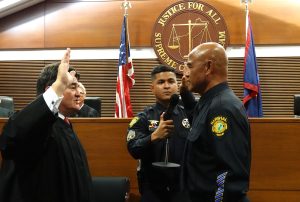Prank call mars WMD drill
A prank call marred the synchronized anti-terror exercise at the Saipan Harbor yesterday morning, with law enforcers rushing to a reported chemical spill on Middle Road, which turned out to be a hoax.
Law enforcers from the Department of Public Safety and other first responders turned on their sirens and hastily responded to the alleged chemical spill incident on Middle Road after a caller notified authorities of the incident before 11am.
Authorities, however, found no chemical spill or the caller who claimed to have come from the hospital. The call is still being determined if it was a deliberate prank or part of the exercise.
According to Sgt. Tony Macaranas, they received a call for assistance before 11am when the exercise was just about to end. Law enforcers immediately rushed to the scene and made immediate inquiry.
“There was no chemical spill. I don’t know if it was a prank call. But there was no incident there,” said Macaranas.
Aircraft Rescue and Firefighting Division chief Stanley Torres Jr. said a portion of the exercise included a call from the hospital about a chemical spill but the caller was supposed to notify law enforcers that the call is part of the exercise.
“The hospital should tell them that it is the exercise. But there was no word ‘exercise’ so police officers went out to check it. They immediately responded to that incident,” said Torres in a separate interview.
Operation Safe Harbor is a full-scale anti-terror attack exercise to test the coordination, cooperation, and the first-responders skills in case a chemical and explosive attack incidents.
The exercise, which began at 8am and ended in an ARFF briefing around 4pm, was hosted by the Emergency Management Office in coordination with the EG&G Technical Services.
EMO director Rudy Pua said the exercise intends to evaluate first responders and response agencies protocols in responding to a weapon of mass destruction terror incident.
“The operation will provide an opportunity for team training of local agencies. [It will] assess coordination and response functions under the Incident Command and Unified Command systems. [It will] assess mutual aid agreements,” he said.
Pua said the operation is funded through the State Homeland Security Grant Program by the Office for Domestic Preparedness under the U.S. Department of Homeland Security. He did not clarify the approximate amount that was granted.
“In fiscal year 2003, the Office of Domestic Preparedness provided millions that was broken down into four categories—planning, training, exercise, and equipment. We still have funds, and it will be used for the operation,” he said.
Pua said the exercise would be conducted annually.
“The goals of Operation Safe Harbor are to validate the CNMI Emergency Operations Plan, Terrorism Response Annex, and Hazardous Material procedures. The evaluators also looked at the community and local entities’ roles, responsibilities, and plans and procedures in response to an act of WMD/terrorism,” he stressed.






